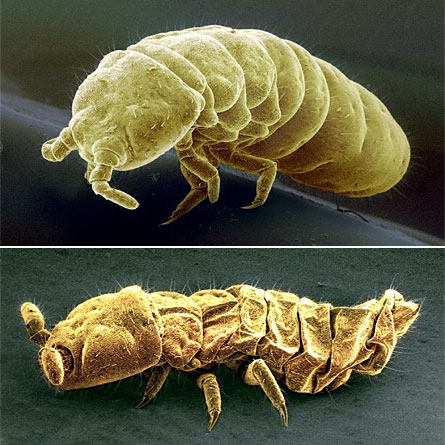- More than 2 years ago
Instead of chopping firewood and pulling out the mittens to prepare for chilly winter days, the Arctic springtail hunkers down and dries itself out. A study published online July 21 in BMC Genomics identifies some of the genes that allow for the millimeters-long arthropod’s extreme wintering stunt.

When temperatures drop below freezing, Arctic springtails (Megaphorura arctica) lose a massive amount of water and shrivel into little husks. In this way — a method called cryoprotective dehydration — the critters ride out harsh winter temperatures. When conditions improve, the animals rehydrate, dust themselves off and crawl away.
“This whole question of what happens during dehydration is terribly interesting,” says David Denlinger, an insect physiologist at Ohio State University in Columbus. “Here is an animal that has figured out how to survive — dried out.”
Study leader Melody Clark of the British Antarctic Survey, based in Cambridge, and her colleagues collected springtails from mossy areas beneath cliffs in the Arctic and took them back to the laboratory in England. Once there, the researchers set up an experiment to monitor which of the springtails’ genes are active during dehydration and rehydration.
“We’ve tried to emulate what happens in winter,” Clark says. Because room temperature is too balmy for the Arctic animals, she and her colleagues kept the springtails at about 5º Celsius (41º Fahrenheit) and gradually chilled them to -7º C. Between 0 and -2º C, the springtails started to darken and shrivel, eventually entering dormancy. Some of the springtails were allowed to gradually warm back up to 5º C over the course of 18 hours.
Using a hand-built gene chip that catalogues thousands of Arctic springtail genes, the researchers found genes that were active in the shriveled, dry animal and genes that were active after the animal had just rehydrated. Clark says the experiments turned up many of “the likely suspects,” genes whose products help protect cells from damage under extreme conditions.
For instance, the gene for trehalose, a sugar that serves as cellular antifreeze, was more active when the springtails were dehydrated, the researchers found. Genes that encode proteins that continuously help refold damaged proteins were also more active in the dehydrated state. “These genes help keep everything going until conditions return to normal,” Clark says. As the animals rehydrated, genes that encode proteins important for producing energy and remodeling tissues were more active, providing a genetic glimpse into the recovery process.
Not much was known about the genes responsible for such extreme survival, Denlinger says. “This paper provides the best datasets so far, and points to interesting clues about how it [the springtail] survives.”
Understanding animals’ strategies for getting through harsh conditions — particularly freezing temperatures — may be relevant for the medical field, including long-term tissue storage, Denlinger says. Of the Arctic springtails’ tricks, he says, “It would be a wonderful thing if we could do that to transplant tissues.”






